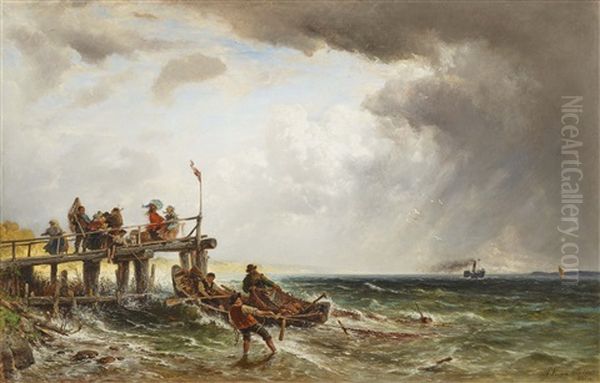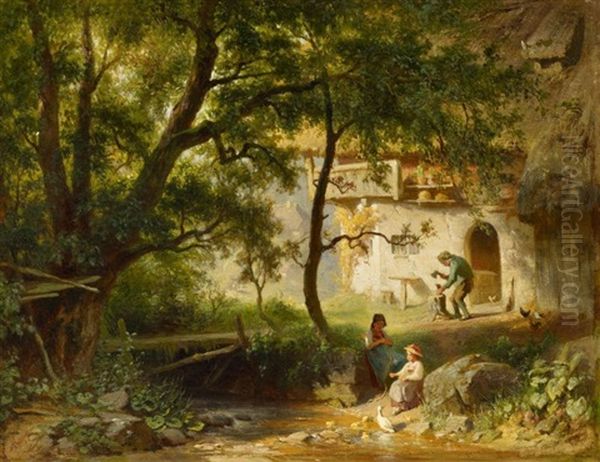
Albert Kappis stands as a significant figure in 19th and early 20th-century German art, primarily celebrated for his evocative landscape paintings. Born in the town of Wildberg, nestled within the scenic Black Forest region (Schwarzwald) in 1836, Kappis dedicated his artistic career to capturing the nuances of nature, particularly the atmospheric qualities of the German countryside and beyond. His life spanned a period of profound change in European art, witnessing the transition from Romanticism through Realism to the dawn of Impressionism, elements of which subtly infused his work. He passed away in Stuttgart in 1914, leaving behind a legacy of paintings cherished for their sensitivity to light, mood, and place.
Early Life and Artistic Formation
Kappis's origins in Wildberg likely provided him with an early appreciation for the natural world, a theme that would dominate his artistic output. The dense forests, rolling hills, and distinct atmosphere of the Black Forest offered a rich visual environment. Seeking formal training, Kappis pursued his art education in two major German artistic centers: Stuttgart and Munich. Stuttgart, the capital of Württemberg, possessed a respectable art academy, while Munich was rapidly ascending as a leading hub for artistic innovation in Germany, particularly during the latter half of the 19th century.
His time in Munich was especially crucial. The city was home to the influential Munich School, a broad movement characterized by its emphasis on Realism, painterly technique, and often, genre scenes or landscapes imbued with a sense of tangible reality. Studying in this environment exposed Kappis to prevailing artistic trends and connected him with the ideas circulating among prominent artists of the day. This academic grounding provided him with the technical skills necessary to translate his observations of nature onto the canvas.
Influences and the Munich Milieu

The artistic development of Albert Kappis was significantly shaped by his contemporaries, particularly those associated with the Munich School and the evolving trends in landscape painting. The provided sources explicitly mention the influence of painters such as Eduard Schleich the Elder, Adolf Heinrich Lier, Ludwig Willroider, and Carl Ebert. These artists were instrumental in moving German landscape painting towards a more intimate and atmospheric approach, diverging from the grand, often idealized vistas of earlier Romanticism.
Eduard Schleich the Elder (1812-1874) was a leading figure in Munich landscape painting, known for his moody, atmospheric depictions of the Bavarian countryside, often focusing on dramatic skies and the effects of light. His work likely encouraged Kappis's own sensitivity to weather and atmosphere. Adolf Heinrich Lier (1826-1882), another key influence, studied in Munich and was deeply impacted by the French Barbizon School, particularly artists like Jean-Baptiste-Camille Corot and Théodore Rousseau. Lier championed the concept of the paysage intime (intimate landscape) in Germany, focusing on simpler, more personal views of nature rendered with tonal subtlety.
Ludwig Willroider (1845-1910) and Carl Ebert (1821-1885) were also part of this circle. Willroider, known for his poetic landscapes, shared an artistic friendship with Ebert, from whom he received valuable advice. Their collective emphasis on capturing the mood and specific character of a place, often incorporating elements of rural life or folklore, resonated strongly with Kappis. These interactions and shared artistic goals fostered an environment where capturing the subtle interplay of light, water, and clouds became paramount for conveying atmosphere.
Artistic Style: Realism Meets Atmosphere
Albert Kappis's style can be best understood as rooted in the Realism of the Munich School but evolving to incorporate a heightened sensitivity to atmospheric effects, bordering on Impressionistic tendencies. While perhaps not a full-fledged Impressionist in the French sense, like Claude Monet or Camille Pissarro, Kappis clearly demonstrated an interest in capturing fleeting moments of light and weather. His travels, potentially including trips to France, may have further nurtured this interest.
His technique involved careful observation of nature, but his aim was not mere topographical accuracy. Instead, he sought to convey the Stimmung – the mood or spirit – of the landscape. This is evident in his handling of light, whether it's the soft glow of twilight, the dramatic contrasts of an approaching storm, or the dappled sunlight filtering through leaves. Water bodies, like Lake Starnberg or the Chiemsee, frequently appear in his work, allowing him to explore reflections and the interplay of light on surfaces. Cloud formations were not just background elements but active participants in creating the overall atmosphere of his scenes.

Compared to some of his Munich contemporaries like the meticulous realists Wilhelm Leibl or Wilhelm Trübner, Kappis often adopted a slightly looser, more painterly approach, particularly in his later works. His brushwork, while controlled, could effectively suggest texture and form without laborious detail, focusing the viewer's attention on the overall composition and mood.
Signature Subjects and Locations
Kappis is renowned for his depictions of specific German landscapes, particularly those in Bavaria and his native Swabia. Lake Starnberg (Starnberger See) and the Chiemsee were recurring subjects, their expansive waters and surrounding scenery providing ample opportunity to study light and atmosphere. His painting Aufziehendes Gewitter am Starnberger See (Gathering Storm on Lake Starnberg), dating from around 1874, exemplifies his ability to capture the dramatic tension of changing weather over the lake.
The Neckar River valley also featured in his work, as seen in Neckar bei Berg. This piece is noted for its depiction of a "gloomy summer evening," showcasing Kappis's refined sense of color and his skill in rendering specific times of day and their associated moods. His connection to his homeland remained strong, and the landscapes of the Black Forest and Swabia provided continued inspiration throughout his career.
Beyond Germany, Kappis also explored other locales. His work Am Comer See (On Lake Como), dated 1880, indicates travels to Italy. Such journeys often exposed German artists to different light conditions and landscapes, sometimes leading to a brighter palette or new compositional strategies, enriching their artistic vocabulary. This painting suggests Kappis's versatility and his engagement with the broader European landscape tradition.
The Intimate Landscape: Paysage Intime
The influence of Adolf Lier and the French Barbizon School (including artists like Charles-François Daubigny alongside Corot and Rousseau) steered Kappis and his circle towards the paysage intime. This approach favored smaller, less grandiose scenes compared to the heroic landscapes of earlier periods. It focused on the quiet beauty of the countryside, often featuring simple motifs like a cluster of trees, a bend in a river, a rural path, or farm buildings.
Kappis excelled in this genre. His painting Vor dem Bauernhof (Before the Farmhouse), created sometime before 1900, is a prime example. It likely depicts a tranquil rural scene, focusing on the textures of buildings, the quality of light on the fields, and perhaps the quiet rhythm of country life. These works often possess a gentle, contemplative quality, inviting the viewer into a specific, relatable moment in nature or rural existence. The human element, if present, is usually integrated harmoniously within the landscape rather than dominating it.
Another work mentioned, Blätterwerk vor einem Fenster (Foliage before a Window), suggests an even more intimate focus, possibly a study of light filtering through leaves or the juxtaposition of interior and exterior space. Such studies highlight his keen observation skills and his interest in capturing subtle visual effects, characteristic of an artist deeply engaged with the act of seeing.
Kappis in the Context of German Art
Albert Kappis worked during a vibrant period in German art history. The dominance of the Munich School provided a strong foundation in realism and technical skill. Figures like Carl Spitzweg captured the Biedermeier charm of everyday life, while Franz von Lenbach became a celebrated portraitist. Kappis, however, carved his niche within landscape painting, aligning himself with the atmospheric realists.
He navigated the currents leading towards modernism. While artists like Max Liebermann would become leading proponents of German Impressionism, Kappis represented a more gradual absorption of impressionistic ideas into a fundamentally realist framework. He shared this transitional space with other notable German landscape painters of the era, such as Hans Thoma, known for his idyllic, sometimes symbolic scenes, or the Achenbach brothers, Oswald and Andreas, who represented a more dramatic, Düsseldorf School-influenced style of landscape. Kappis's contribution lies in his consistent focus on mood and his sensitive rendering of the specific character of Southern German landscapes.
His association with Schleich, Lier, Willroider, and Ebert places him firmly within a significant network of Munich-based landscape artists who collectively pushed the boundaries of the genre in Germany. While the sources indicate influence and shared artistic concerns rather than specific collaborative projects or joint exhibitions with these named individuals, their collective impact shaped the direction of landscape painting in the region.
Later Years and Legacy
Albert Kappis continued to paint into the early 20th century, eventually passing away in Stuttgart in 1914. His work remained committed to the principles developed throughout his career: a deep connection to nature, a mastery of atmospheric effects, and a style that balanced realistic observation with painterly sensitivity. His paintings found homes in private collections and galleries, appreciated for their tranquil beauty and evocative power.
His legacy is that of a dedicated and skilled landscape painter who captured the essence of the German countryside, particularly Bavaria and Swabia, with remarkable feeling. He stands as an important representative of the Munich School's landscape tradition, particularly its evolution towards the paysage intime and its engagement with the atmospheric concerns that paralleled French Impressionism. His works offer a window into the natural world as seen through the eyes of a sensitive observer, adept at translating light, air, and mood onto the canvas.
Albert Kappis may not have sought the radical breaks of the avant-garde, but his consistent dedication to his vision produced a body of work that continues to resonate with viewers who appreciate finely wrought, atmospheric landscape painting. He remains a respected figure within the rich tapestry of 19th-century German art.